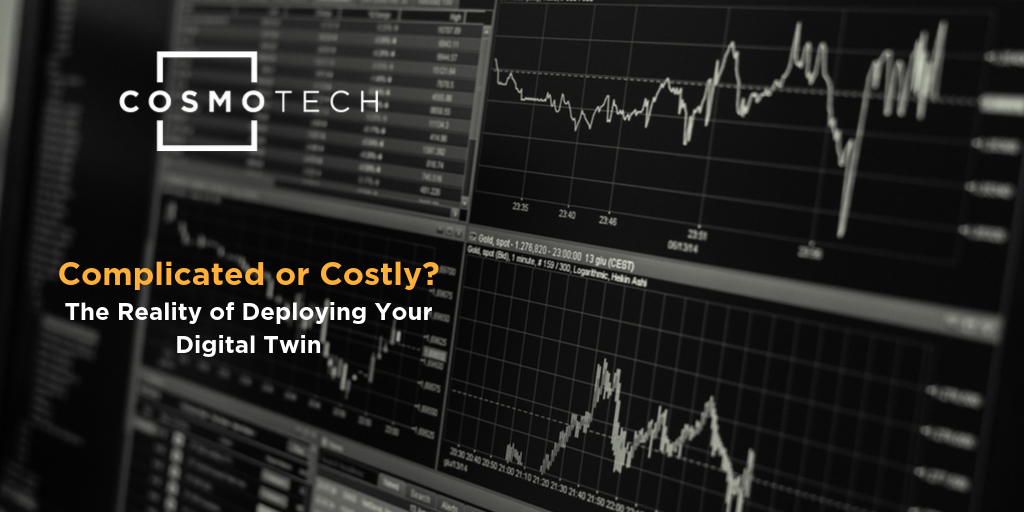There’s little doubt that digital twins are increasingly popular solutions for companies seeking to lift productivity, increase efficiency, and optimize their resources. Right across the industrial landscape digital twins are helping decision makers to make better long term investments, plan their most important maintenance operations, and respond in real-time to shifts in supply and demand in even the most complex supply chains.
Yet for some decision makers there remains a reluctance to embrace digital twins.
Executives worry that digital twins, for all their promised transformational impacts, will be too expensive or too complicated to deploy. With shareholders and stakeholders both sensitive to increased spending today predicated on only the potential for returns tomorrow, this reticence in the C-suite is at least understandable. Indeed, as Gartner reports, despite some 75% of firms either already adopting digital twins or considering doing so, a full quarter of companies have no plans to move on the technology anytime soon.
When it comes to digital twins, though, the case for adoption is strong. With deployments of mature digital twin solutions measured in weeks and returns on investment (ROI) realised rapidly, digital twins are neither complicated or very costly for industrial customers to embrace. Indeed, as the digital twin market gets set to explode ten-fold in the coming years, the greatest cost to a business might be the choice to not deploy digital twins and thus miss out on the clear and accessible benefits this technology offers.
‘We Want You to Lift Our Profit Margin by 20%’
In the automotive sector Toyota is famous for its kaizen approach to innovation in manufacturing. Kaizen translates as ‘improvement’ and the system that Toyota has put in pace across the organization seeks to make thousands of small improvements to systems, policies, and processes so that, in total, the company is more efficient, more productive, and more profitable. All these marginal gains, all these 1% improvements on dozens of tasks are part of the reason that Toyota has been ranked the most valuable automotive brand in the world every year since 2013.
So when UK consultants Challenge Advisory were asked by an automotive manufacturer to improve annual profit margins by 15-20% while simultaneously cutting the time to manufacture a vehicle down to just 13 hours they were facing a challenge well beyond the reach of Toyota-style marginal gains. Challenge Advisory needed a game-changing technological solution, and they found it in a digital twin.
After a period scoping resources and data requirements, establishing monitoring systems, and installing additional sensors in the manufacturing plant, the Challenge Advisory team deployed a digital twin in just fourteen days.
And the results for the manufacturer?
Profit margins didn’t increase by 20% but instead by an average of 41-54%. In addition, improvements to processes and an optimized manufacturing line saw the time to build a vehicle plummet not to 13 hours but to less than 10 hours. The results, as Challenge Advisory report modestly, “greatly exceeded our client’s expected outcomes”.
Low Cost via Quick ROI is the Norm for Digital Twins
40% improvements in profit margins make for a quick ROI and a relatively low-cost eventual deployment of digital twins, but are these sorts of results typical? According to independent research from LNS the answer seems to be ‘yes’.
LNS found that “nearly 60% of companies expect to recoup their investment [in digital twins] within one year”.
On the back of such speedy and cost-efficient returns to industrial customers, LNS expects that initial investments in digital twin technologies will explode. Today some 40% of initial forays into digital twins are investments of $1 million or less; by 2024 LNS expects that 40% of initial spends will be $5 million or higher, a clear testament to the quick ROI that digital twins generate.
Building on the Data You Already Have
Achieving an ROI so quickly is not only an indicator of the cost-efficiency of digital twin technologies but also a strong indicator of how uncomplicated their adoption is for most businesses.
Modern industrial companies have often already embraced the monitoring technologies that feed data to digital twin models. Often the biggest challenge for a business is not gathering the data that digital twins need but instead centralising that data and coordinating systems it available to the digital twin software solutions.
Experienced digital twin vendors help their customers to identify the critical data they will need to take full advantage of their digital twin technologies and work with them to make the transition to digital twins seamless and simple. At Cosmo Tech, for example, a client can expect to deploy a functional digital twin within weeks of a contract being signed no matter whether that client is a national electricity utility, a global automobile manufacturer, a regional energy generator, or the world’s leading aerospace actor.
Uncomplicated and Inexpensive
Building on data that companies already have and with a quick return on investment, a digital twin is both relatively uncomplicated and inexpensive. The ease and speed of adoption of digital twins is one of the drivers of their rapid spread across industry and the reason why investments in this transformational technology are expected to explode in the next five years.



.png?w=1080&ssl=1)